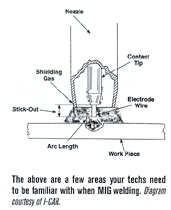Recently, I was asked to inspect a vehicle with representatives from the California Bureau of Automotive Repair (BAR). The car in question was a 1998 Toyota Corolla. The vehicle owner was picked up at the accident scene by a sub-standard tow company and taken to an “unqualified” body shop. There, the shop owner promised the vehicle owner a free rental and said he’d save her deductible.
Sounds too good to be true, doesn’t it?
It was. Six months later, the repair still wasn’t finished, the shop had never given her a rental and, you guessed it, they cashed her check.
The car owner’s insurer towed the vehicle from the shop and brought it to me for an inspection. The BAR got involved looking for fraud, but they couldn’t find any. The shop performed all the operations specified in the estimate, but the quality of repairs was so bad the vehicle was a total loss. The car wasn’t pulled properly — which could’ve been corrected — but the welding was another story. It was obvious the person who welded the frame rail, apron and core support had no idea how to MIG weld. In fact, I’ve seen beginning welding students do a better job.
Welding is probably the least understood repair procedure in the collision industry, yet it’s the most critical of any repair process. And it’s time that we as owners, managers and estimators look closely at the GMAW process and stress its importance to techs.
Defining the Task at Hand
The term GMAW stands for gas metal arc welding, or to you and me, MIG (metal inert gas). GMAW and resistance spot welding are the only approved welding methods on today’s vehicles.
A few areas your techs need to be familiar with when welding include shielding gas, stick-out, electrode wire, nozzle and gun angle. See diagram.

Shielding gas is used to protect the molten weld puddle from contamination from the surrounding air. The best gas mixture for welding mild- and high-strength steel is a mixture of 75 percent argon and 25 percent carbon dioxide. This mixture will produce a stable and smooth arc, and give the tech a cleaner weld (less spatter). Using this gas will also improve the strength of the tensile and the yield strength of the weld.
Stick-out refers to the length of the electrode wire from the contact tip to the end of the wire. The best wire size for you to use is .023-inch wire. The stick-out length should be from 1/4 inch to 3/8 inch with that wire size. A rule to repair by: Every time you begin a new weld, cut off the weld ball at the end of the wire.
It’s also important that your techs use the proper gun angle, depending on the type of weld to be performed. Gun angle is the angle measured from the work surface to the nozzle. The three most common welds performed every day are butt joint with a backer, lap joint and plug weld. On these welds, your techs should be using the following gun angles:
- Plug weld at 90 degrees.
- Lap joint at 45 degrees.
- Butt or fillet weld at 70 to 75 degrees.
Avoid Weld Failure
One of the most common mistakes I notice when I teach welding is improper gun angle. It’s also the biggest reason for weld failures. Other common reasons for weld failure include:
• Incomplete fusion — when a gap occurs between the base metal and weld metal.
To correct the problem:
- Reduce your travel speed.
- Increase the current.
- Check gun angle.
• Porosity — a void in the weld metal scattered in small clusters or along the entire length of the weld.
To correct the problem:
- Keep welding gun nozzle clean (use anti-spatter spray and welding pliers).
- Reduce stick-out.
- Decrease travel speed.
- Decrease current.
- Increase flow rate of gas.
- If your tech is welding in an area that’s drafty, use a welding screen. Wind will blow away the shielding gas.
- Make sure the all-welding surfaces are clean.
• Weld spatter — particles of metal that sit on the surface and aren’t part of the weld. These metal particles take time to clean up, create poor welds and waste electrodes.
To correct the problem:
- Decrease current.
- Decrease travel speed.
- Shorten stick-out.
• Melt-through — occurs when the welding arc burns through the base metal.
To correct the problem:
- Decrease current.
- Increase travel speed.
- Reduce the gap between the two pieces of weld metal on a butt joint with backer. Rule of thumb: The opening should be twice the thickness of the weld metal.
Ensuring a Strong Bond
The best way to make sure your techs are welding to acceptable industry standards is for them to take — and pass — the I-CAR Welding Qualification test. You might think the test is too expensive and that you can’t afford to lose your technician for any amount of time, but what price do you put on your customers’ safety?
Contributing Editor Toby Chess, AAM, is the Los Angeles I-CAR chairman, an I-CAR instructor and a certified ASE Master Technician.













